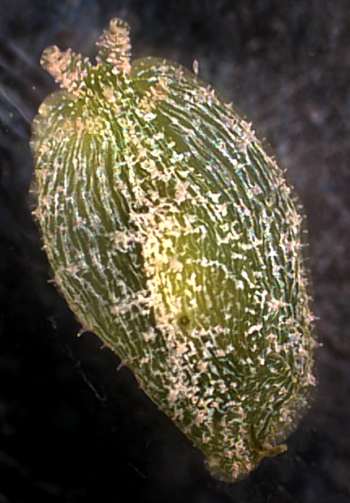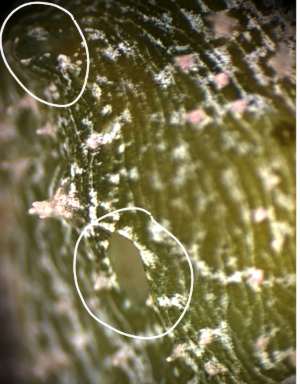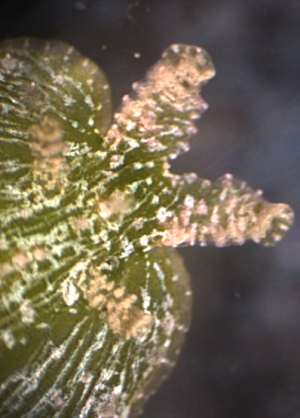Phyllaplysia from Tampa Bay, Florida
January 14, 2004
From: Nicholas Curtis

Dr. Rudman,
This little guy was found on a batch of sea grass (Thallassia testudinum) collected in shallow water near the sunshine skyway in Tampa Bay [Florida, USA] by Jen Sneed. The slug appears to have two sets of rhinophores, and, although very difficult to see, appears to have a posterior mantle cavity. I was wondering if you could assist us with its identification.
Thank you
Nicholas Curtis
Department of Biology, SCA 110
University of South Florida
4202 East Fowler Avenue
Tampa, Florida 33620
USA
ncurtis2@helios.acomp.usf.edu


Dear Nicholas,
This is a cryptic Sea Hare of the genus Phyllaplysia and name which can be translated as 'leaf sea hare' for obvious reasons. The two pairs of rhinophores you describe are in fact an anterior pair of oral tentacles and a posterior pair of smaller rhinophores. You are correct in identifying the posterior mantle cavity. In the lower left photo I have ringed the inhalent and exhalent openings into the mantle cavity which is almost completely enclosed by the parapodia which are fused except for the flap region in your photo. There is sometimes a small platelike shell remnant in the mantle cavity but in some animals this is absent.
I suspect your animal is Phyllaplysia engeli which is widespread in the warm water western Atlantic from Brazil to the Caribbean. However Kerry Clark (1977) described a second species from Florida, Phyllaplysia smaragda which may be this animal. Clark notes a number of anatomical differences which I obviously can't compare, and a few external differences. In particular he described P. engeli as having a rounded body while P. smaragda was elongated. He also described the oral tentacles of P. engeli to be flattened and distinctly separated while those of P. smaragda were rounded and joined at the base. Unfortunately in your photo the animal seems to be rounded as in P. engeli but have oral tentacles that fit the description of P. smaragda.
At present I can only say it is a species of Phyllaplysia. I think it will need someone with local knowledge of these species to identify it to species. It is of course possible that P. smaragda is a variety of P. engeli, but again someone would need to study populations of both to sort this out. Certainly both species occur in Florida.
If you can give me some information on when the animal was collected and its size that would be useful
• Clark, K.B. (1977) Phyllaplysia smaragda (Opisthobranchia: Notarchidae), a new anaspidean from Florida. Bulletin of Marine Science, 27(4): 651-657.
Best wishes,
Bill Rudman
Related messages
-
Re: Phyllaplysia smaragda or P. engeli from Florida
From: Geoffrey Smith, July 9, 2008 -
Phyllaplysia smaragda or P. engeli from Florida
From: Geoffrey Smith Jr., July 8, 2008 -
Phyllaplysia engeli from Florida
From: William Schill, January 29, 2005
